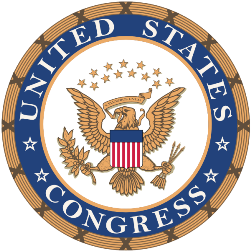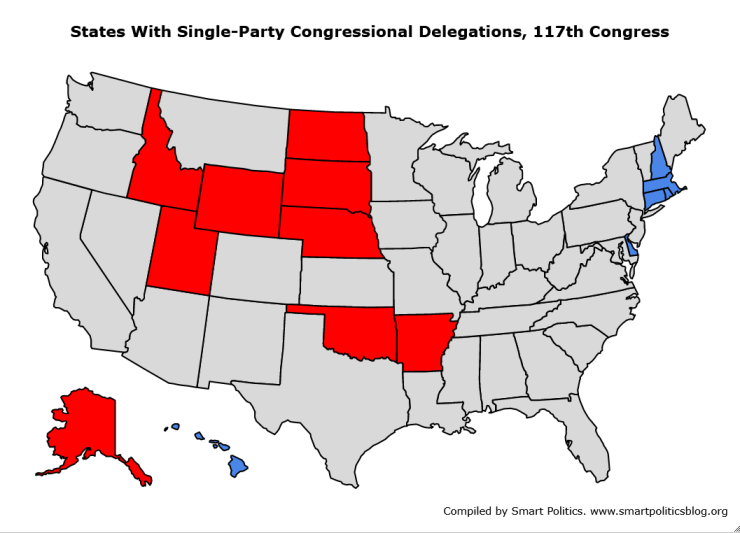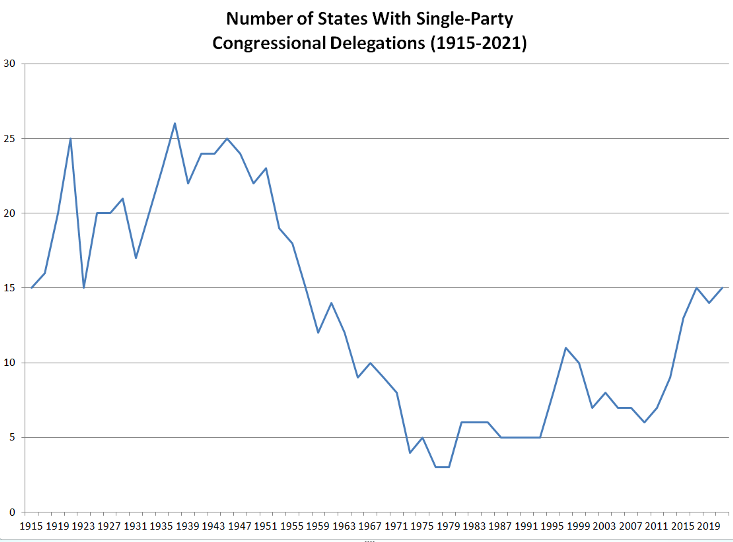The Rise of Single-Party State Congressional Delegations
The 117th Congress matches a 60-year high in the number of states represented by just one party on Capitol Hill

The 117th Congress was also convened on Sunday with 15 state delegations with each U.S. Representative and both U.S. Senators from the same party – tied for the largest number of states since the late 1950s.
The current congress has nine all-Republican delegations (Alaska, Arkansas, Idaho, Nebraska, North Dakota, Oklahoma, South Dakota, Utah, Wyoming) with six represented by Democrats (Connecticut, Delaware, Hawaii, Massachusetts, New Hampshire, Rhode Island). [Note: Vermont is not included in the Democratic column because Senator Bernie Sanders appears on his state’s ballot as an independent, not a Democrat].
That marks a net increase of one state from the 116th Congress and matches a 60-year high last seen during the 115th Congress.
In the 2020 cycle, Democrats lost their monopolistic control in New Mexico when Republican Yvette Herrell unseated freshman Xochitl Torres Small in the state’s 2nd CD. Republicans, meanwhile, regained control of all congressional seats in Oklahoma and Utah – knocking freshmen out of office in the 5th (Kendra Horn) and 4th (Ben McAdams) CDs respectively.
At least 13 states have been represented by one party in congress for each of the last four congresses.
The last time that occurred was during the 82nd (23 states), 83rd (19 states), 84th (18 states), and 85th (15 states) Congresses from 1951-1959.
By contrast, after the 2008 election, there were just six states with single-party representation in Congress: Hawaii, Massachusetts (until Scott Brown won a 2010 U.S. Senate special election), New Mexico, North Dakota, and Rhode Island for the Democrats and Wyoming for the Republicans. That marked the lowest number since 1993 when there were just five single-party states: Hawaii, North Dakota, and West Virginia for the Democrats and Alaska and Wyoming for the GOP.
The nine Republican-controlled states in the 117th Congress is tied with the 115th Congress for its peak since the 84th Congress (1955-1957) when every seat in nine states appeared in the Republican column: Iowa, Kansas, Maine, Nebraska, New Hampshire, North Dakota, South Dakota, Utah, and Vermont.
The 15 states represented by one party in D.C. in 2021 is nearly twice the average level seen across the previous 30 election cycles since the 88th Congress convening in 1961 with an average of only 7.9 states represented by one party during this period.
The 117th Congress also has five times the number of single-party delegation states since bottoming out at just three states during the 95th (1977-1979) and 96 (1979-1981) Congresses.
The recent rise in single-party representation in the states reflects what was quite common during the early- to mid-20th Century.
From the 64th (1915-1917) through the 85th (1957-1959) Congresses, no fewer than 15 states sent single-party delegations to D.C. with an average of 20.6 states doing so each cycle.
Democrats peaked at 23 states during the 75th Congress after the 1936 landslide while the GOP hit a high water mark during the 67th Congress after lassoing every seat in 17 states after the Election of 1920.
Overall, states have sent single-party delegations to Congress 718 times since the 64th Congress (1915-1917). A total of 431 of these were all-Democratic and 287 were all-Republican.
Nearly every state has sent at least one single-party congressional delegation to D.C. during this 100-plus year span with the only exceptions being California, Illinois, Missouri, New Jersey, New York, Ohio, and Tennessee.
Of the remaining 43 states:
- 14 states have alternately seen their delegations completely controlled by both major parties: Alaska, Arkansas, Connecticut, Delaware, Nevada, New Hampshire, New Mexico, North Dakota, Oklahoma, South Dakota, Utah, Washington, West Virginia, and Wyoming
- 17 states have had only uniform Democratic control: Alabama, Arizona, Colorado, Florida, Georgia, Hawaii, Kentucky, Louisiana, Maryland, Massachusetts, Mississippi, Montana, North Carolina, Rhode Island, South Carolina, Texas, and Virginia
- 12 states have had only uniform Republican control: Idaho, Indiana, Iowa, Kansas, Maine, Michigan, Minnesota, Nebraska, Oregon, Pennsylvania, Vermont, and Wisconsin
North Dakota is the only state to have logged at least 10+ Congresses with its seats under control of Democrats (12 times) and Republicans (24 times).
Democrats dominated the South for many decades during this span with southern states holding six of the top seven slots for the most cycles with all-Democratic delegations since the 64th Congress: Mississippi (28), Georgia (27), Louisiana (27), Arkansas (26), Alabama (25), and South Carolina (25). Rhode Island (27) is also tied for second on this list.
Many states with moderate to large populations in the Midwest and Northeast saw the Republican Party hold every congressional seat at some point during the last century:
- Pennsylvania: All 38 U.S. House and Senate seats in the 69th (1925-1927) and 71st (1929-1931) Congresses
- Michigan: All 15 seats in the 67th (1921-1923), 70th (1927-1929), 71st (1929-1931), and 72nd (1931-1933) Congresses
- Indiana: All 15 seats in the 66th (1919-1921) and 67th (1921-1923) Congresses
- Iowa: All 13 seats in the 65th (1917-1919), 66th (1919-1921), 67th (1921-1923), 68th (1923-1925), and 69th (1925-1927) Congresses and all 10 seats in the 79th (1945-1947), 80th (1947-1949), and 84th (1955-1957) Congresses
- Wisconsin: All 13 seats in the 65th (1917-1919), 66th (1919-1921), 67th (1921-1923), and 71st (1929-1931) Congresses and all 12 seats in the 80th Congress (1947-1949)
- Minnesota: All 12 seats in the 67th (1921-1923) Congress
- Kansas: All 10 seats in the 67th (1921-1923) Congress
Overall, Vermont has tallied the largest number of cycles with an all-Republican delegation since 1915 with 29 followed by New Hampshire (27), Idaho (25), North Dakota (24), and Wyoming (24).
Several states in the 117th Congress are one seat shy of single-party representation with the GOP one seat away in nine states (Alabama, Iowa, Kansas, Kentucky, Louisiana, Mississippi, Montana, South Carolina, West Virginia) and Democrats one seat away in five others (Maryland, Nevada, New Mexico, Oregon, Vermont).
Pending redistricting and retirements, a handful of these 14 states have a reasonable chance of coming under single-party representation in future congresses – Iowa, Kansas, Montana, and West Virginia for Republicans and New Mexico and Vermont for the Democrats.
Follow Smart Politics on Twitter.



For ND, that would officially be the Democratic Nonpartisan League party that monopolized the Congressional delegation.
Arguably, the House monopoly or just majority control would be most impactful if the POTUS election were to be determined by the chamber (each STATE casts 1 vote).